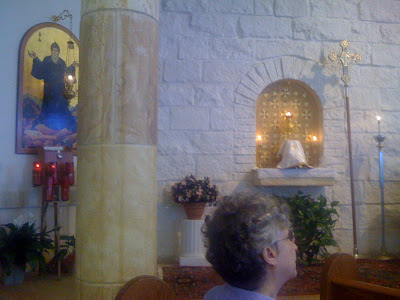Visiting a Maronite church in Austin
Traveling southward for a family reunion (the wife's Polish family) in the Austin/Houston area we were lucky enough to be able to go to a Maronite Qorbono before returning home. More lucky still were we that there was a baptism during the liturgy so that I was just another in attendance taking pictures (albeit with an iPhone).
Completely uninitiated in the liturgics of their liturgy I can only say that it seemed a mix of Syriac, Latin, and Byzantine practices rolled into one. The parishioners, while largely Lebanese, were also a representative cross-section of the area.
The "green book" they use is based on the 1992 universally accepted liturgy. There has also been a very recent synodal meeting which will further reorient the liturgy to its historical roots. I'm told some word will come out on this in the future (less than five years).



Completely uninitiated in the liturgics of their liturgy I can only say that it seemed a mix of Syriac, Latin, and Byzantine practices rolled into one. The parishioners, while largely Lebanese, were also a representative cross-section of the area.
The "green book" they use is based on the 1992 universally accepted liturgy. There has also been a very recent synodal meeting which will further reorient the liturgy to its historical roots. I'm told some word will come out on this in the future (less than five years).


I think the versus populum is a corruption. The Maronites are very Latinized.
ReplyDeleteIf I recall correctly, the 1992 decree requested that ad orientem was to be used when the prayers were addressed to the Lord, the genuflection replaced by a bow and Aramaic (instead of the Arabic vernacular) used during the Canon. Did you see this when you were there?
He did face the people.
ReplyDeleteThe bits that were not in English were listed as Syriac.
As to the bow/genuflection I can't recall.
What was odd was that most of the music was traditional save for the entrance hymn, which was a standard Roman hymn I've heard quite often.
The baptism seemed like a standard Roman baptism except that the congregation as one faced West then East.
On Wednesdays Liturgy is Ad Orientem in the Chapel
ReplyDelete